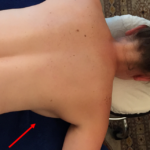What Ethics Training Should Spas Provide to Massage Therapists? Part One
August 29, 2025

In any day spa or wellness-oriented business that employs massage therapists, it is imperative that management provides ethics training to its employees. Not only does ethics training bridge the gap from schooling, but it also provides another screening opportunity for any hires with predatory tendencies. Therefore, one key benefit of ethics training for massage therapists is the prevention of sexual assault and misconduct. In order to receive that benefit, what ethics training should spas provide to massage therapists?
Requirements for massage therapist ethics training:
- Covers ethical principles, boundaries, communication, and sexuality
- Live and interactive, with challenging role-plays and discussions
- Taught by skilled instructors to coach and test therapists
Why Should Spas Provide Ethics Training to New Hires and Employees?

First, it’s important to know why spas should even provide this ethics training, rather than skipping it and relying on a therapist’s schooling. For background context, massage schools in the United States are not standardized, and license requirements vary across all 50 states.
Some schools teach 50 to 100 hours of ethics, while others teach only 5-10 hours of these subjects. For example, Florida requires a mere four hours on this vital topic, not nearly enough time for a proper education. In order to ensure all employees have the same understanding, spas must provide ethics training.
And even more important than standardizing knowledge across spa staff, ethics training done correctly enables management to assess a new hire’s relationship with boundaries and to spot any predatory tendencies that were not recognized in the verbal or practical interviews.
When Should Spas Provide Ethics Training to Massage Therapists?
It’s important for spas to provide ethics training to all new hires during onboarding. Not just for new hires, though, ethics training should also be repeated throughout the year. Ethical issues, dilemma’s and principles should be discussed, and role played so that the concepts become easier and easier to understand and use.
During this training, if a therapist is unable to set proper boundaries, they should not be hired, as this is not safe for their clients. And if a therapist demonstrates concerning behavior, such as making an off-color comment to the trainer or the colleague they are practicing on, they should be terminated immediately.
What Defines Adequate Ethics Training?

Ethics training for massage therapists must involve a thorough understanding of ethical principles, boundaries, communication, and sexuality. Nothing can replace live ethics training – it must be live, interactive, and taught by skilled instructors. It involves practicing ethical dilemmas and providing feedback, as well as engaging in discussions. It consists of trainers setting up scenarios, in which to observe and coach therapists while they role-play complex interactions, and then testing their knowledge. This is the only way to know that the practitioner has absorbed and integrated the information. Reading about these topics or watching videos on them is helpful, but it is totally inadequate by itself.
1. Ethical Principles
There are four principles of ethics that should be covered:
- The first principle is beneficence, doing good, acting in the best interests of others, and promoting well-being in health care.
- The second principle is avoiding malfeasance, not hurting others, or doing no harm. This includes having and abiding by professional standards, licensure, and a code of ethics.
- The third principle is autonomy, which means that people have the right to make decisions based on their values and wishes. It includes the right to be safe and control what happens to your body. It is the basis for informed consent, telling the truth, and confidentiality.
- The fourth principle is justice, which in this context means referring to the principle of treating everyone fairly and impartially, treating everyone equally regardless of their circumstances, and doing the right thing in a given circumstance.
2. Interpersonal Boundaries
There are also four interpersonal boundary categories that are essential:
- Physical Boundary: how and where do I allow touch on my body
- The client sets the physical boundary, and the professional therapist follows the client’s guidance on where they work and how much pressure they use.
-
- An unprofessional therapist will ignore the client’s guidance, which can include too much pressure to the point of pain and too little pressure such that the client feels like it is a waste of time.
-
- A predatory therapist can use light touch, which has a sexual overtone.
- Emotional Boundary: how much of my feelings do I share
- The client sets the emotional boundary, and the professional therapist listens to the feelings they share without judgment or advice. The professional therapist might inform the client that their issues are not within their expertise, and they might suggest a therapy that addresses emotional well-being.
-
- An unprofessional therapist will take this topic as a signal to discuss, interpret, give advice, or even share their own personal feelings
-
- A predatory therapist may use their client’s feelings as a way to manipulate them or target them for inappropriate touch.
- Sexual Boundary: you can touch my body, but not in a sexual way
- For massage therapy, this boundary should never be crossed. The professional therapist creates clear sexual boundaries by securely draping the client at all times and only exposing the areas to be worked on. They touch the client with firm hand contact and never go near the genitals, anus, or female breasts.
-
- An unprofessional therapist is careless with draping, and their draping might be loose or sloppy.
-
- But a predatory therapist intentionally drapes loosely or inappropriately. They may bring their hands under the drape, work very high on the upper inner thigh, and touch the breast or genital region, which is never appropriate.
- Intellectual Boundary: who do I share my beliefs and ideas with
- Professional therapists maintain a rigid intellectual boundary and do not enter into discussions about politics, religion, money, spirituality, and so forth.
-
- An unprofessional therapist would broach these topics during a session.
3. Communication
Professional boundaries are created and maintained through clear, thoughtful, and precise verbal communication. This kind of skillful communication is not innate to most people; it must be taught, observed, and verified. That way, the instructor knows what the therapist is capable of so that they can teach them what they are lacking.
And the only way to teach communication is through role-play training. Therapists are taught how to handle clients who ask questions that are too personal, make off-color jokes, deal with sexual arousal, or ask them out on a date. The therapist must be coached and given feedback, or this training will be ineffective.
4. Sexuality
Massage therapists must be educated about and understand sexuality. Massage, by its very nature, is an intimate act. Where else do you walk into a room, disrobe, and have a person you just met touch your unclothed body?
This is a professional, one-way physical intimacy that is not sexual in any way. But without an understanding of sexuality, this vulnerable setting can create confusion on the part of the client and/or the therapist.
Key points for this subject are to understand why a male client may innocently become sexually aroused and how to handle that situation with kindness and care. Or in the case of a predatory client who becomes sexually aroused, how to use firm, assertive communication. These skills can only be accomplished through interactive training, including roleplays with a skilled teacher.
In Part Two, I will elaborate on the challenging role-plays and discussions that ethics training must include, as well as why a skilled teacher is required and what kind of curriculum they must teach.
If you’re a lawyer who is currently involved in a sexual assault case and needs an expert witness with a massage or spa background, schedule a conversation with Dr. Benjamin.
Ben E. Benjamin holds a Ph.D. in Sports Medicine and has been an expert witness in cases of sexual assault in a massage/spa setting since 2004, advising lawyers, testifying in depositions and trials, and writing reports. His expertise extends beyond massage therapy and ethical behavior. He also advises spas, both large and small, on the creation of comprehensive sexual assault prevention strategies that ensure safe and ethical practices in the industry.
What Ethics Training Should Spas Provide to Massage Therapists? Part One FAQs
- Why should spas provide ethics training to new hires and employees?
Ethics training bridges the gap from massage schooling, provides another screening opportunity for predators, and aids in the prevention of sexual assault and misconduct in businesses that employ massage therapists.
- When should spas provide ethics training to massage therapists?
For new hires, it should be provided during onboarding. For all employees, it should be repeated
- What defines adequate ethics training?
The curriculum must be taught by a skilled instructor and cover ethical principles, boundaries, communication, and sexuality. The training must be live and interactive, with challenging role-plays and discussions.
- What are the four ethical principles massage therapists should learn in ethics training?
Beneficence, malfeasance, autonomy, and justice.
- What are the four interpersonal boundaries massage therapists should learn in ethics training?
The physical boundary, the emotional boundary, the sexual boundary, and the intellectual boundary
- Why and how should massage therapists learn communication in ethics training?
The professional boundaries that massage therapists need to create and maintain require clear, thoughtful, and precise verbal communication. The only way to teach communication is through role-play training.
- Why and how should massage therapists learn about sexuality in ethics training?
Without an understanding of sexuality, the vulnerable setting of massage can create confusion on the part of the client and/or the therapist. Addressing sexual arousal in a variety of situations can only be accomplished through interactive training, including role-plays with a skilled teacher.
Related Posts

Expert Witness Insight: Sexual Assault and Poor Draping in Massage Therapy
What is Draping in Massage Therapy? Draping in massage therapy means securely covering the body with a sheet, blanket, and/or towel so that the private areas of the body are covered, feel safe, and are not ever exposed. These areas include the genitals, the female breasts, and the lower buttock, where the gluteal cleft is, […]

How High is Appropriate to Massage on the Upper Inner Thigh?
How High on the Upper Inner Thigh to Massage? The upper inner thigh is one of the gateway areas where predator massage therapists begin their sexual assault. The thigh should be draped so that the pelvis and the inner thigh are securely covered. The drape is generally a sheet tucked under the thigh and […]

Expert Witness Insight: When Massage Therapists Work on the Buttocks
When massage therapists work on the buttocks, clear communication is needed so the client feels safe. This area of the body is not usually touched by anyone other than an intimate partner. Consent is Required for Work on the Buttock in Massage Work in this sensitive area necessitates a conversation with the client before […]

Expert Witness Insight: Touching the Side of the Breast When Lying Face Down
Touching the Side of the Breast When Lying Face Down I would say that more than 99% of massage therapists are ethical professionals who would never commit a sexual assault on anyone. Massage therapists who are sexual predators are usually male and frequently test and groom the clients they choose to assault sexually. For example: […]

Working On the Chest in Order to Move to the Breast
Working On the Chest in Order to Move to the Breast When working on the pectoral muscles, the drape is lowered slightly. The pectoral muscles can be massaged appropriately, working not more than one or two inches below the collarbone. The point is that therapists are trained to work on the pectoral muscles while avoiding […]
